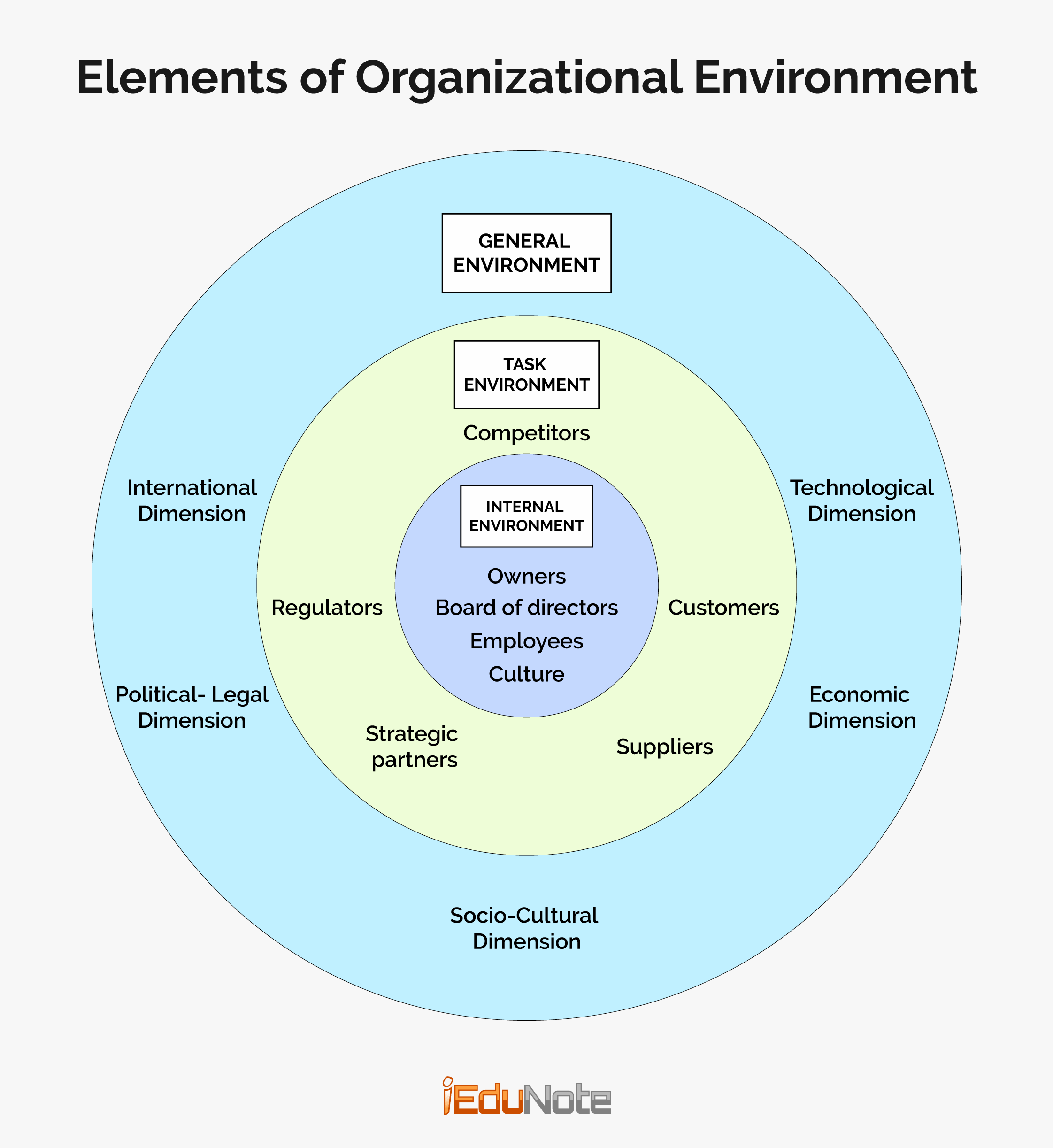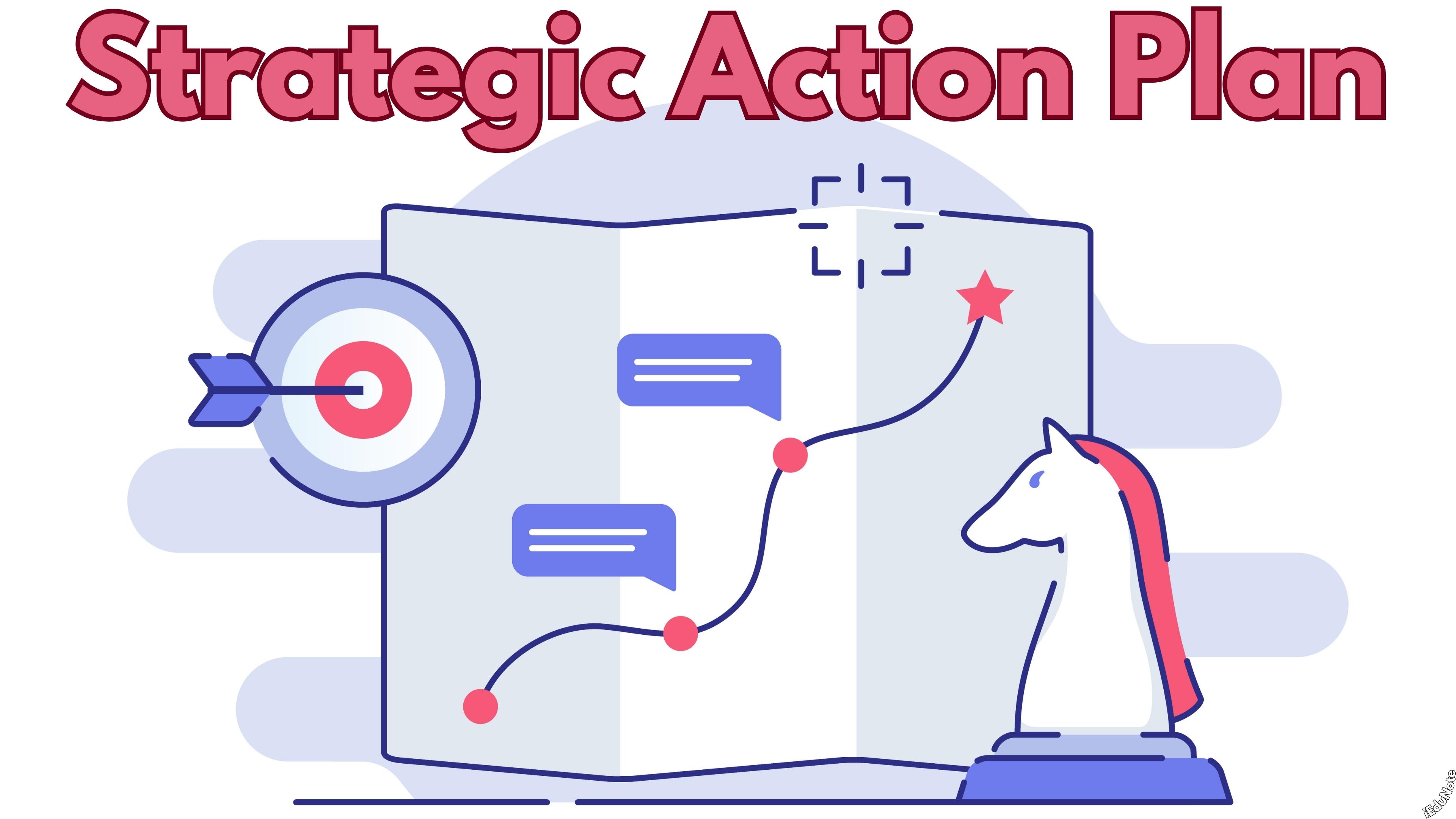Overall scope and direction of a corporation and how its various business operations work together to achieve particular goals. Corporate strategy refers to the overall strategy for a diversified company.
Since a diversified company has a combination or mix of several businesses in multiple industry environments, the corporate strategy embraces the whole mix of businesses.
It also embraces the ways of coordinating and integrating the strategies of individual business units.
The corporate strategy aims at improving the attractiveness and performance of the diversified company’s overall business.
What is Corporate Strategy?
As Michael Porter pointed out, corporate strategy concerns itself with four concepts companies commonly use; portfolio management, restructuring, transferring skills, and sharing Activities. He put more emphasis on the last two issues.
He said, “Companies have the best chance of being successful at diversification if they capitalize on the existing relationships between business units by having them transfer skills and share activities.
The corporate strategy aims at improving the attractiveness and performance of the diversified company’s overall business. The process of allocating resources among the various strategic business units (SBUs) is the responsibility of the top-level corporate managers.
They decide and implement how cash, staffing, equipment, vehicles, finances, and others. Resources will be distributed among the SBUs.
The scope of corporate strategy is much broader – issues of diversification, adding new products or services, competing with other firms, developing cooperative relationships, and the like.
Meaning Of Corporate Strategy
The corporate strategy concept was developed in the early 1960s. Defining the business in practice meant choosing the optimum product market scope (Ansoff, 1968). The external environment determined the scope.
Over the years, the criteria of choice about the appropriate product market scope has enlarged owing to the changes in the external conditions where products, markets, technology, resources, and risks are global, local and go-local (local impacted by global).
According to Brown (1997), the early idea about corporate strategy is “opportunity divided by capability.” The option where capability in terms of the internal factors best matched the external challenges was the best.
It is the different strengths within an organization that enable adaptation. Once the choice is made for a particular scope to be pursued, the organization has to allocate resources to get results from that scope at the intended time.
Resources must be complemented with steering towards results tiding over managerial, strategic, and financial or governance-related difficulties.
Building Blocks Corporate Strategy?
This is the commitment to the strategy. Three building blocks of corporate strategy are thus defined in this module:
- The options and the pathways to attain them (e.g., growth through expansion in global markets).
- Sustaining the strategy through resource allocation (e.g., allocate resources from business A which is mature, to business which is emerging), and
- Committing to strategy (resolving managerial or strategic problems through the parent entity).
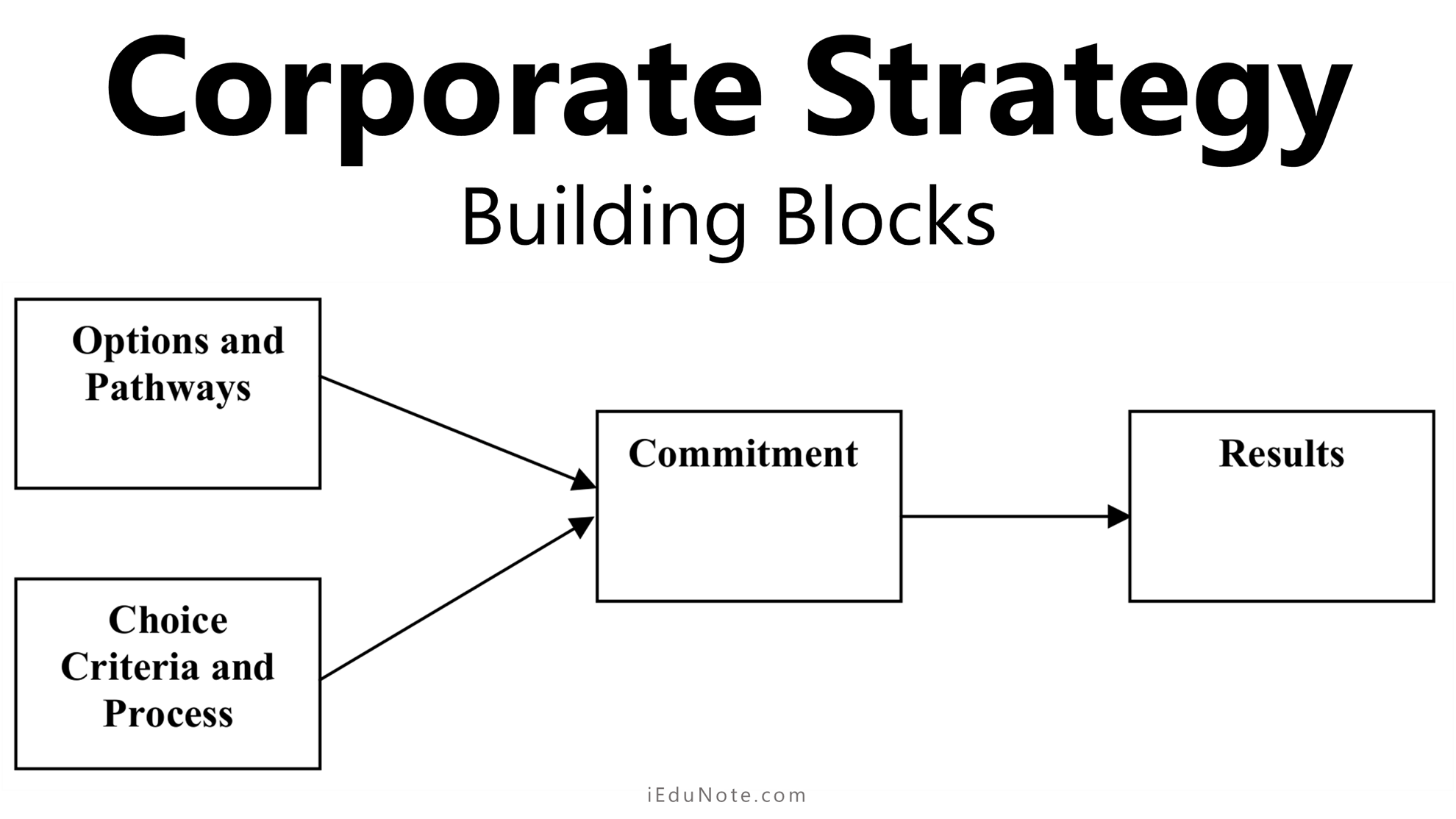
The current understanding of corporate strategy suggests that an organization’s sustainability and profitability depend on the value the organization creates for customers.
One has to delineate the customers and markets one would serve and then concentrate on the value one would create.
- Does the organization bring something new to the customers?
- How does it make a difference through innovation, service, newness, and affordability?
- A sound value proposition attracts customers and, in turn, leads to profitability.
Profitability is rooted in bringing the right combination of product, technology, the price point at the right time to the right market.
Organizations such as General Electric, Sony, Honda, Coke, Pepsi, Dell, Samsung, Walt Disney, and Apple are successful contemporary companies. They manufacture and market their products globally.
Analyzing this more closely will make it clear that each has opted to grow differently from others.
Apple products may be more homogenous globally than those of General Electric or Pepsi, which have modified their products to suit the different customer needs of their diverse markets (for example, the United States, India, Brazil, and China).
Each of these companies has followed different strategies to attain its position. Some have diversified extensively, some have grown in a broad segment, some have gone global, and some have been restricted to a few countries (options).
Again each of the different businesses they operate in has its different strategies.
For example, Apple may have a different growth strategy in North America than in Asia, even if it markets similar products on both continents.
General Electric may choose to serve Asian diagnostic markets differently than the European market (pathways).
From its current operations, we infer the present strategy of the organization. From the investment portfolio, it is developing, to some extent, the futures markets and technologies products it might develop (future scope).
The grand strategies explain the scope of the activities, the logic, and the context of choice based on the premises of this reasoned evolution. The grand strategies also referred to here as the options are growth, stability, retrenchment, or a combination of the three.
Many sub-options are referred to as pathways within each of these broad options.
Among the options;
- Stability implies a state of status quo, or rather a state where the activity level is significantly lower than it is in the growth phase.
- Growth implies an expansion in the level of operations of the organization.
- Retrenchment implies a state of a deliberate cutback in activities. It is the “pruning of activities” stage.
- A combination implies the balancing act between different businesses for sustained profitability.
Implementation of Corporate Strategy
Strategies that have been formulated now have to be put into action. Implementation has been described as the “managerial exercise of putting the chosen strategy in place” (Thompson & Strickland, 2003).
As the strategies are implemented, the existing/old order in the organization will yield the new one. Implementation implies an organization-wide change at different levels among different activities, resources, and configurations.
Implementation or execution of strategy has to be planned so that it happens.
Implementation or execution, as it is also called, is perceived by most chief executives to be a more difficult task than formulation because it is the active change and how it takes place at the ground level that determines the success or failure of strategy.
Implementation has two aspects, an analytical aspect and a people aspect.
Moving the people towards the action is an important job in implementation, which is leadership-contingent.
The deliverables of the implementation process are scattered across the functions/activities of the organization and have to be aligned, altered, and people-activated to achieve the deliverables through rewards and leadership.
Managing the change process is integral to implementation. People, as doers and leaders, play a pivotal role in implementation. People are the owners and drivers of change.
The people in the organization must know about the rational change, the sequence of the change, and the realignment of resources, structure, positions, and skills as part of the change process. The middle and lower-level managers push the changes.
Implementation requires a different set of skills and mindsets. Domain, business, and people skills are important to steer the implementation process.
Implementation is impossible unless there is a plan, and the linkage between strategy and implementation is clearly understood and may be revisited often.
Culture, structure, business-level leadership, knowledge, and information sharing significantly mediate implementation. This module explains the different aspects of implementation.
Implementation Imperative of Corporate Strategy
Implementation/execution leads to results. According to Ram Charan (2002, p.5), “Most often today, the difference between a company and its competitors is the ability to execute.
If your competitors are executing better than you are, they are beating you in here and now, and the financial markets won’t wait to see if your elaborate strategy plays out.
So leaders who can’t execute don’t get free runs anymore. Execution is the great unaddressed issue in the business world today”.
Implementation can be defined as the “let’s make things happen” phase that tests a manager’s ability to allocate resources, lead the organization towards change, restructure operations, motivate people to develop a strategy-supportive culture and meet or beat or beat performance standards.
A mediocre strategy can yield results if the implementation is good, but a great strategy cannot yield results if the implementation is weak.
4 Situations in Terms of Optimality of Implementation Versus Quality of Formulation
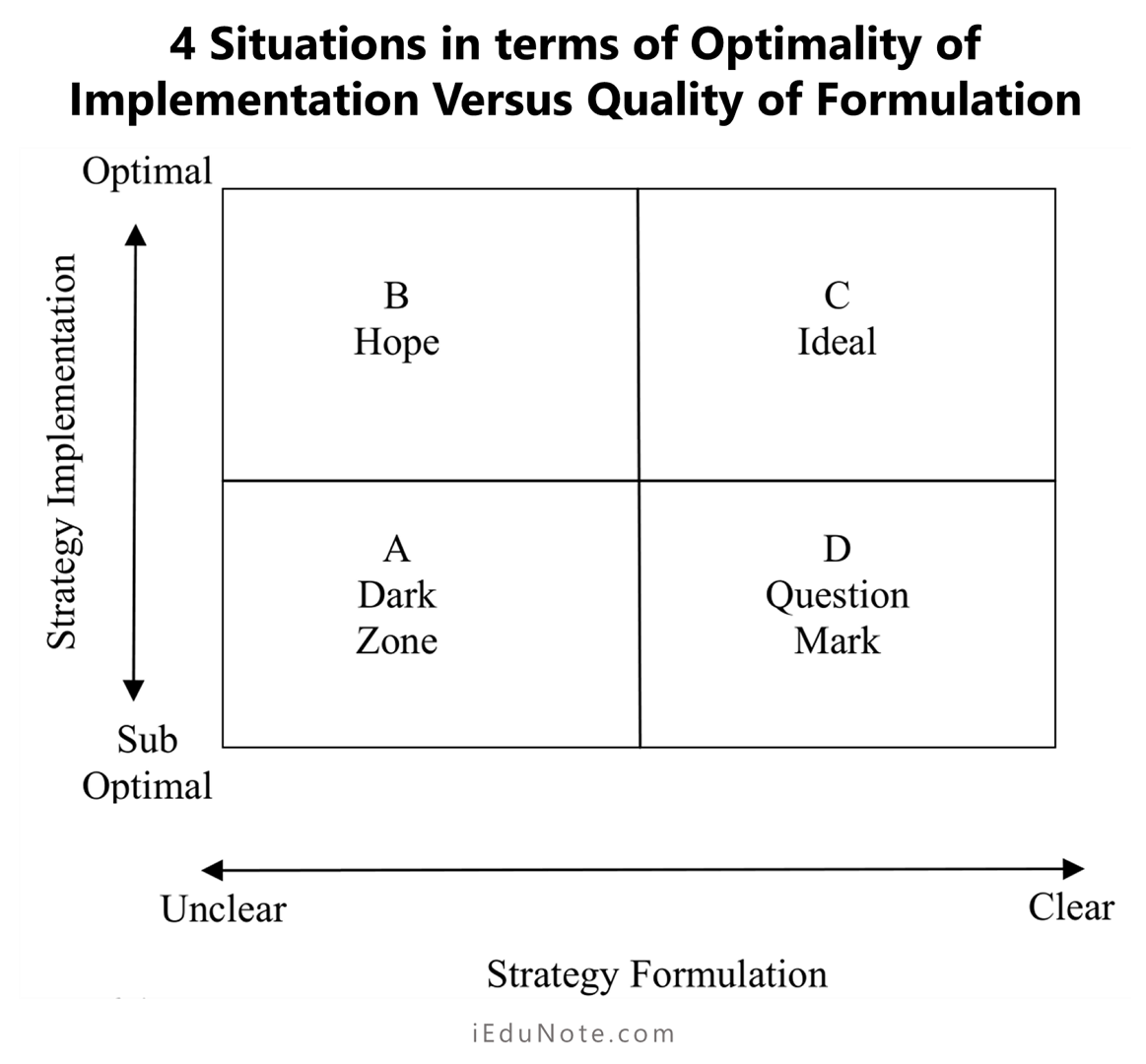
The 2×2 matrix figure above presents the four situations in terms of implementation optimality versus formulation quality.
The four combinations that emerge are:
- Optimal implementation and excellent formulation (quadrant C) in ideal situations.
- Excellent formulation and sub-optimal implementation (quadrant D) in a situation of uncertain results.
- Suboptimal implementation and poor formulation (quadrant A) grim situations.
- Optimal implementation and poor formulation (quadrant B) situations of uncertain results.
Quadrant C is the ideal situation for any organization. For organizations caught toward quadrants D or B, the managerial initiative will play an important role in salvaging the situation.
It is generally said that a poor formulation can be salvaged at the time of implementation, but it is more difficult to salvage a poor implementation.
Implementation or execution is the phase where the abstractness of the formulation is translated into specific, clear programs.
The two phases are differentiated more in theory for understanding than in practice, where they are interlinked and iterative. An implementation may become easier if the implementation issues and bottlenecks are discussed at the time of formulation.
Formulation and implementation are differentiated in terms of the nature of the process, participants, skills, and deliverables, as shown in Table.
Difference Between Strategy Formulation and Strategy Implementation
| Formulation | Implementation |
| – It is an analytical process. – It is market-driven and entrepreneurial. – The focus is on the future. – Select a few to participate in strategy formulation. – Requires analytical skills, vision, and a sense of business. – It can be abstract. – Is the idea centric? | – It is the action/doing process. – Operations and business process-driven. The focus is on the present. – Every employee has to be a part of strategy implementation. – Requires the ability to lead, reconcile differences, make quick decisions, and have people skills. – It has to be specific and detailed. – Is performance-centric. |
Implementation Process of Corporate Strategy
Implementation involves the entire organization.
Let us not assume that implementation is smooth and that everything is critical to making the strategy fall into place. There is neither a shortcut nor a checklist for implementation.
If it were so, managerial talent would not be at a premium.
There is a multitude of intertwined tasks that have to be performed to precision. Implementation is challenging because, during this phase, the strategy may change based on real-time learning.
As the actualization of strategies takes place, many unforeseen situations develop – erratic supplies, shortage of workforce, change in external conditions, and so on. These compel managers to work within emergent circumstances.
Some components of the strategy may become unattainable and have to be dropped (for example, an organization in pursuit of growth may decide to expand operations and reduce prices.
Its decision is based on the premise that an increase in production capacity by setting up a new plant will result in significant cost advantages.
As it begins to set up the additional facility for capacity expansion, the competitors also begin capacity expansion. Still, they outsource instead of manufacturing, obtaining the same cost advantages as its expansion would provide.
Should the organization continue to lock up resources even if returns will be far below anticipations or reassess the situation and revise the strategy?
Upon the analysis, it decides to forgo capacity expansion by building a new plant and instead serve a differentiated class with an improved product and better service at higher prices.
Its original business plan changed, and the organization plans to spend on developing resources for the emergent strategy.
Its plan to expand is dropped (unrealized strategy), and its plan to invest in improvising the product and service is implemented (emergent strategy).
The emergent strategy may have been a backup plan or emerged post-analysis of the unrealized strategy.
This means that during implementation, there may be a realization about the unfeasibility, inappropriateness, and/or impossibility of going ahead with a chosen strategy.
The readiness to evaluate the unrealized proposal and accept a new one in the light of professional and technical advice requires a high degree of communication, clarity, mutual trust, and high professional competence among the top and functional managers.
Strategy Process Concepts Contexts Cases
This pattern of change in the strategies;
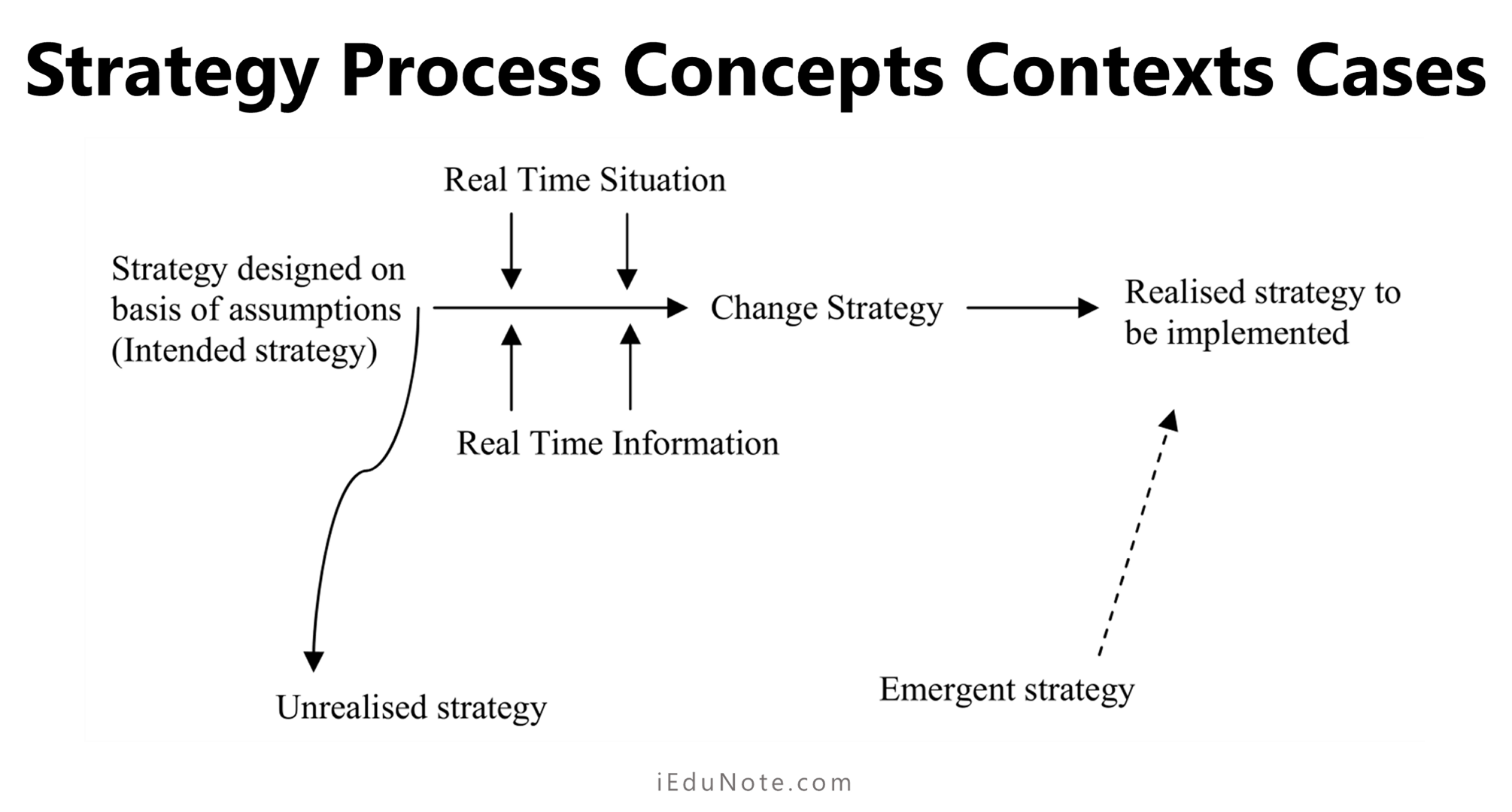
The activity, division, department, and/or function “silos” created to facilitate day-to-day functioning must be broken down to facilitate cross-functional/departmental/team learning and actions through specific projects.
These silos harbor tough resistance to cross-functionality, knowledge sharing, knowledge transfer, or sharing of resources for optimization. The resistance can be behavioral, procedural, resource contingent, or driven by the organization’s coalitions and politics.
Strategy-specific resources may have to be allocated along with strategy-specific disbursement, measurement, and control that can be attained only through special-purpose vehicles created in implementation.
Resource allocation would inevitably create imbalances, disgruntlement, frustration, and questioning. Clarity of purpose and communication here is the way to resolve the impasse.
Strategic change may have to be initiated organization-wide, with some areas changing in more ways than others. Issues, problems, and conflicts endemic to change must be addressed, as would be the case with post-merger cultural integration.
Many people-related issues would arise as the integration is carried out, which may have been overlooked or seemed trivial during the merger/premerger.
Elements of Corporate Strategy
Implementation is a complex process.
It requires the provisioning of leadership, people, resources, and an enabling culture to transform the relatively abstract conceptualizations of the formulation into specific goal-directed plans, programs, and performance targets.
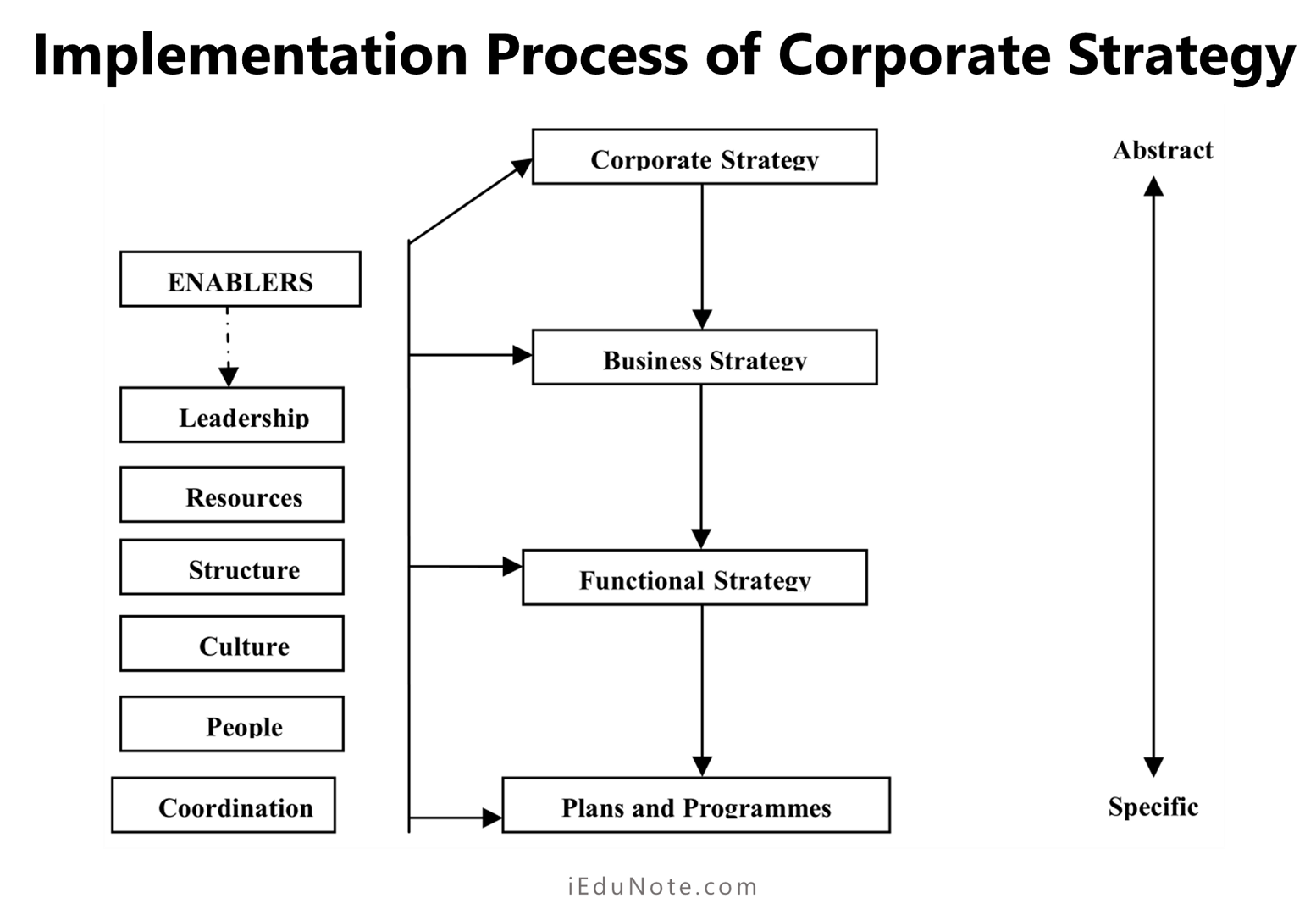
These elements are;
- Leadership
- Resources
- Structure
- Culture
- People
- Coordination
Leadership
Objective: To lead the change and to create ownership of strategy at all levels.
Leadership can make or mar implementation. Hrebiniak (2005) states, “Leadership must be execution biased.”
If not, the organization may flounder in its attempt to change and implement. Leaders lead by example.
Personal integrity, commitment, inspiring people, and the ability to take a risk are the leadership qualities sought in organizational leaders. Implementation presents new challenges every day.
Leadership is critical to implementation because implementation is as much an analytical operations process as it is a people’s process.
A leader’s upfront involvement with execution sends a message of commitment, a comprehensive understanding of what is happening, and motivation.
Jack Welch of GE led the six sigma initiative upfront in 1991. This interest, commitment, and projection of involvement established six sigma very well in GE, though initially, he was skeptical of such programs.
The successful organizations of today: Walmart, General Electric, Sony, Apple, Microsoft, Dell, and Infosys, are, to an extent, what they are because of their leadership.
Leadership drives an organization to carry out the implementation process well and successfully. Leaders own the execution, create ownership down the hierarchy, and motivate accomplishment.
Therefore, the first requirement of good leadership is at the strategic level. Did the strategic leaders perceive the crest and pitfalls accurately within a reasonable limit?
Michael Dell’s idea of selling computers directly to customers wasn’t new. Thousands of companies do so. Michael Dell’s “direct sell and build to order approach” was the core of his strategy (Bossidy et al., 2002).
This clarity about what needs to be done to make the strategy work had the backing of foresight and the capacity to lead from the front.
Years later, the Dell model of assembly is the industry norm in the PC industry, and Dell retains a substantive edge because of assiduously building the operations part of the organization lending it some immutable characteristics.
Leadership at the business and functional unit levels must complement strategic leadership.
At these levels, the dominant role of leadership is the front-line mobilization for change and execution. The translation of broad ideas into specific actions with outcomes is contingent upon the ownership and leadership of business and functional-level managers.
The Blake and Mouton (1985) grid of leadership styles places leaders in four quadrants in terms of concern for work or concern for people, as shown in the figure below.
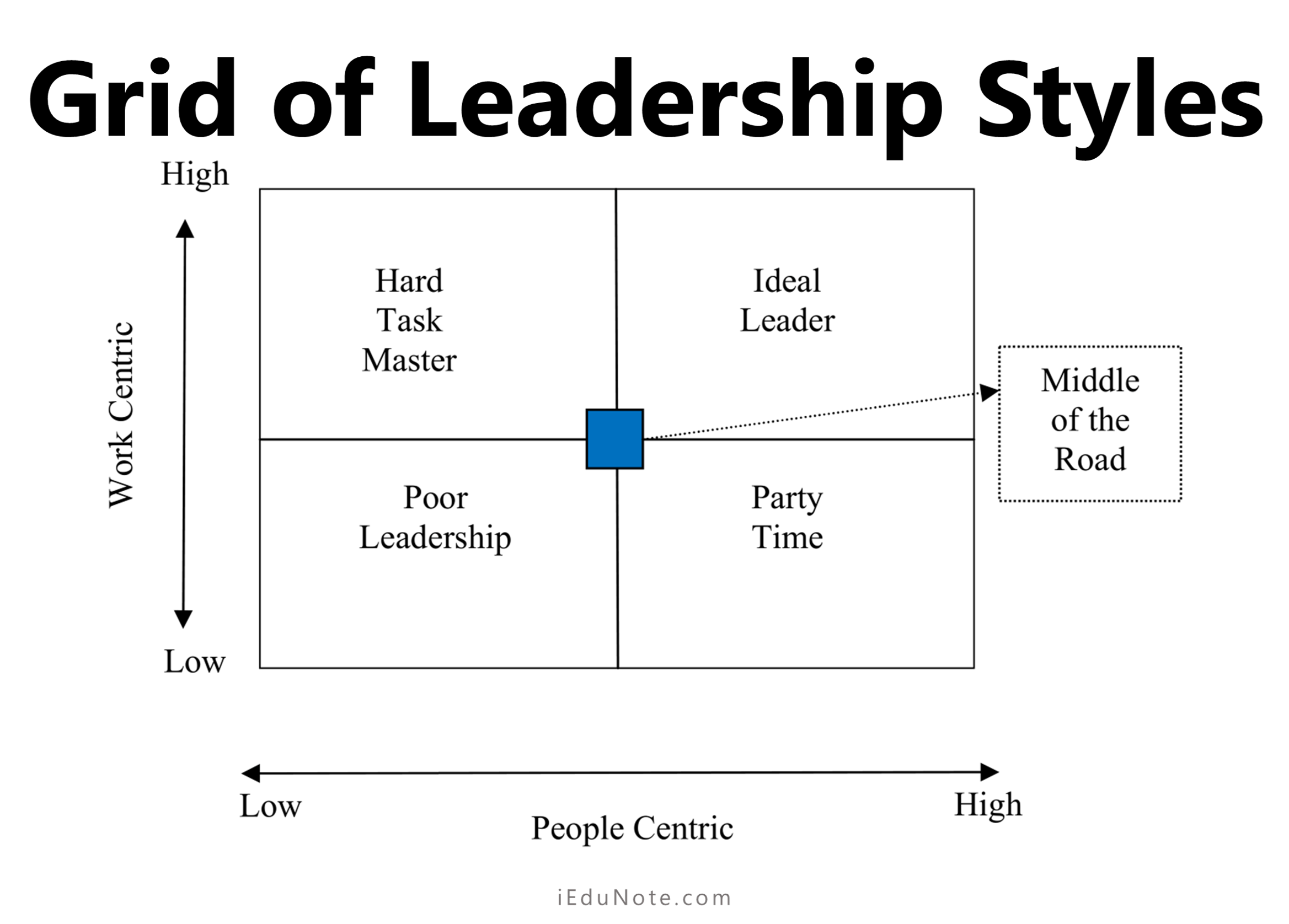
From the figure, we infer that the leaders can be work or people-centric. The work-centric leader is the Hard Task Master and is likely to be good at sequencing tasks and work planning but not at motivation and empowerment.
In the implementation, we need to shift such managers more towards being people-centric. A leader who is too people-centric (Party Time) cannot effectively translate targets into tasks or enforce work discipline.
It is a laissez-faire attitude that permeates the organization.
The two opposing quadrants are the Ideal Leader, who can have a great concern for work as well as for people and can be an asset to the implementation process, and the Poor Leader, who is casual, showing neither concern for people nor work.
A leader’s job in implementation:
- It is to be involved with work to implicitly communicate the importance of initiatives, and desired work-related behaviors.
- Their involvement with people implies being able to motivate them and develop the appropriate physical and cultural environment for performance.
- To be the solution provider.
Implementation needs both transformational and transactional leaders. The distinction between the leadership approaches is in terms of the level at which the leadership is exercised.
People
Objective: To energize the organization.
According to Peter Drucker: “Management is about human beings. Its task is to make people capable of joint performance, to make their strengths effective and their weaknesses irrelevant” (as quoted in The Definitive Drucker by Elizabeth Haas Edersheim, 2007, pp157).
The organization will most likely do a better job if it has a long-term plan to develop people. People are central to implementation.
It is increasingly recognized that all other resources being equal, it is the people factor that makes an enormous difference in the performance of organizations.
People mobilize action towards the desired ends. The people function needs commitment and direction from the CEO. If the CEO fails to do so, strategy implementation is on the wrong footing.
The people aspect of the organization is linked to the commitment of the CEO, the change in culture, and the motivation climate of the organization.
For effective implementation through people, the organization has to:
- Put the right people at the right job.
- The right person in the job at the right time!” Right People” have to be hired and trained with focus, energy, and time. The CEO has to recognize and place those who can deliver on the front lines of implementation; the others will follow. Hiring the right people is the responsibility of the human resources department. It is also a function of culture. Remember, HR performs the activation role, not a policy-making one.
- Training, responsibility assignment, and motivation develop people to their highest potential.
- Once the right people are on board, the next onerous task is to develop them to give their best. In an implementation, the development of people’s capabilities must align with the task ahead. People have an extraordinary capacity to deliver under the right set of circumstances. The people who implement strategy must have integrity, energy, knowledge, and capacity to build the team, lead, delegate, plan, program, and budget. Implementation requires a discipline of time. Employee empowerment and engagement are integral to any organization seeking a predominant position in its industry. People are to be retained and developed continuously and not in a frenzy as a strategic requirement.
- Create a diverse workforce for a knowledge-based digitized workplace.
- Diversity among the workforce brings different perspectives to the organization and enriches its decision-making. Modern organizations have global exposure when they source materials, expertise, and skills. Their home country governments initiate programs of more inclusive employment so that disadvantaged groups, minorities, and women have better employment opportunities. As the case may be, the twin forces of exposure and regulatory pressure or persuasion compelled organizations to broaden the workforce base. They must simultaneously develop plans to enable people to grow and feel equated so that their talent and expertise are used to the fullest for mutual benefit.
- Develop a culture conducive to the growth of people.
- To attract the right people, some changes may need to be made in appraisals, rewards, bonuses, and stock options and also in the climate and culture of the organization. These changes are to be brought about by the top management as they, with line managers, control the accountability and the rewards. The organization must ask: is this the culture we want to work in? Improvements – sometimes radical, sometimes incremental, must follow the No answer.
Resources
Objective: “Tooling” the people for action.
Resources provide the tools and ammunition for the strategy.
Suppose a University wants to increase its Gross Enrolment Ratio and decides to strengthen its open and distance learning program.
In that case, it needs to invest in the latest and most appropriate technology to be able to reach a larger number of students and deliver quality, highly interactive education through the distance mode.
To be able to do so, it needs to have sufficient money, manpower, teaching materials, building and studios, and equipment. Without this, the strategy cannot be realized.
Organizations seldom can claim resource abundance.
The process of developing resources where resource implies capabilities and competencies as well is ongoing. The strategic agenda of the organization determine the priority of the resources.
For example, the uninterrupted working of the furnace in a cement plant requires a constant power supply.
For cement, manufacturer power is a critical resource; provisioning power by the captive power plant is an inbuilt cost. The other resources are less critical than power, coal, and limestone.
However, if the power supply is assured and uninterrupted, the other resources will be given more attention. Resource criticality varies from industry to industry.
Frontline staff is more important in retail, hospitality, and health industries than in steel manufacturing.
Intellectual resources are more critical for design firms, universities, research labs, and industries that survive on innovation than for aluminum smelting. Capabilities for marketing are critical for fast-moving consumer goods and consultancies.
Similarly, organizations differ in their resource access. They can use strategic alternatives only if they have the necessary sources.
Resource constraints impose limits on what an organization can do.
Because of resource, constraint organizations assess resource availability and then use it as a guide in formulating strategy. Financial resources are distributed using portfolio approaches.
For the distribution of talent and competencies, organizations can map the key competencies and leverage them in some instances. Over the long term, critical competencies are to be developed consistently and continuously.
Spreading resources require much ingenuity, and process innovations enable organizations to do so.
Portfolio approaches, such as the BCG matrix and GE Matrix, are used to allocate resources. Still, they may be inadequate to pinpoint the needs of different activities within the given businesses and is needed.
The twodimensional aspects may not capture the intricacies of all the aspects associated with resource allocation, particularly when organizations operate in highly diverse businesses.
Resource allocation can also turn out to be a contentious issue among the different units/functions/activities.
This impasse can be resolved before allocation by a clear, focused strategy and a clear plan for execution. Doubts, misgivings, and ill-informed prejudices are best resolved before allocation rather than after.
Culture
Objective: To develop a fit between strategy and the organization’s routines, beliefs, and actions.
You would have studied culture in other subjects.
Here our concern is to explore its impact on implementation. Culture exists, and it affects and also reflects strategy execution. Culture is not “seen” in the organization; it is palpable.
You can sense whether the organization is brimming with energy or seeped in an attitude of indifference even though no device can measure the energy levels.
Culture also reflects the organization’s core values and beliefs. Culture dominates people’s mindsets about what is doable or non-doable and what is or is not acceptable in the organization. Culture leads to behavior, and behavior leads to performance.
If the organization’s culture fosters excellence, people will learn behaviors that lead to it, which, in turn, will lead to good performance.
Daily rituals reinforce culture. People absorb the culture by observing other people’s behavior and those behaviors that get rewarded.
Do the organization reward initiative and ethical behavior, or does it reward followership?
In the implementation phase, culture can be a stumbling block to initiatives and programs. An organization’s systems, procedures, and beliefs often do not allow it to accept change.
In India, computerization met with much resistance because most employees within public sector organizations did not see it as a tool for increasing productivity but as a tool for replacing manpower.
Functional subcultures reinforce their codes for analysis and behavior. These codes are important to understand and alter to promote cross-functional linkages.
If the strategy requires changes in people’s attitudes and work methods for better performance, issues cannot be addressed by functional systems alone.
The organization will also have to work around the culture and reinforce the desired behaviors through a series of HR-related measures.
Culture broadly represents the “how we do things around here” stance. McDonald’s, where 50 million burgers are made in a day, works on the credo of QSCV (quality, service, cleanliness, and value) across the 34,000 outlets spread across 119 countries.
The credo is enforced daily through training, the actions of supervisors, and control mechanisms.
All organization rituals and actions are in sync with the organization’s idea of affordable food in clean surroundings.
Similarly, suppose an organization wants to put in place a culture that promotes ethical behavior and conduct. In that case, its practices, from the composition of its board to requisition for small items, will be developed to promote the specific culture.
A strategy may require commitment, adherence to certain values, ethical behavior, and service delivery.
If the culture promotes seeking alibis for tasks not done, lackadaisical attitude, and resistance to learning, the strategy has little chance of success. The primary task of culture change is to move people toward the “can-do” side.
A leading example here is that of Wal-Mart. Because of price, Walmart set out to be the preferred destination for purchasing necessity items.
The idea of keeping costs low was reinforced by Sam Walton’s adoption of strategies that, even among senior managers, promoted frugality: hiring self-driven cars instead of limousines on business visits and staying in clean but not fancy places when sourcing products.
Change in culture requires a change in mindsets and perceptions. Culture is not a standalone factor. Cultural leadership and people initiative are closely linked. A great change needs strong leadership pushes along with a change in many human resource-related practices.
Most merger and acquisition failures are because of a mismatch between cultures. A merger brings people from two different cultures together, with the acquired company’s employees feeling threatened by the dominant company.
There is mistrust and apprehension about how the future will unfold regarding compensation, promotion, responsibility, layoffs, salary cuts, demotions, and other cutbacks.
The new joint entity has to deal effectively with them as soon as it can; otherwise, the benefits of the merger will remain elusive.
Strategies that are geared toward cost reduction, innovation, and globalization require discipline. The discipline has to be embedded in the corporate DNA.
Culture can be shaped if there is clarity about the strategy outcomes and change requirements.
Often, strategy is not fully realized because of confusion about what to do, how to handle internal coalitions and politics, and the inability to prioritize or back it in time with resources.
Strategy, people, history, and functional policies are important determinants of organizational culture. Based on these determinants, Nordstrom and The Taj Mahal Hotel have developed a culture of customers first.
Nordstrom’s credo is simple and self-explanatory and is indicative of the extent the frontline salesperson is empowered to promise and deliver for customer satisfaction.
Structure Design
You would have often observed that as the size of the family grows, additional rooms are added, and other activities are undertaken to accommodate the new arrivals. Based on this analogy, let us examine an organization’s growth with the same structure that it set out with.
The organization structure is the arrangement of different positions and roles which have been vested with the responsibility and authority to perform tasks. The structure evolves in response to external changes and the changing dynamics of work within the organization.
You would have read about different structures in your other courses.
A review of those will be of help here. Through the structure, the organization develops operating competency (functional structure), competitive position (divisional structure), multi-functionality (matrix structure), or innovation competence (project structure).
The structure also addresses the issue of the extent of decentralization/centralization and the span of control. No structure form is ideal or a panacea to the difficulties faced in implementation.
In the implementation, the crucial question is: does the structure meet the requirements of the proposed strategy? According to Hrebiniak (2005), the structural requirements of generic competitive strategies are:
| Low cost. Focus. Global. | Functional structure/centralization. Divisional structure/decentralization. Matrix organization. |
| High Market and technology relatedness. | Increased centralization. |
| Low Market and technology relatedness. | Increased Decentralisation. |
| If one is high and the other is low. | Centralization and decentralization. |
Proctor and Gamble once had a divisional product structure to adequately service each of its main product lines. It met the then-competitive requirements of the organization.
However, with global expansion and globalization strategy in emerging markets supported by 127,000 employees, and 300 brands in 180 countries, its coordination management and efficiency needs can no longer be serviced by the same structure.
It needed to develop a simple structure and strengthen both the center and the many different control units across the globe to effectively market PNG’s product across different psychographic, social, and economic segments.
The current structure of P&G is shown in the figure below.
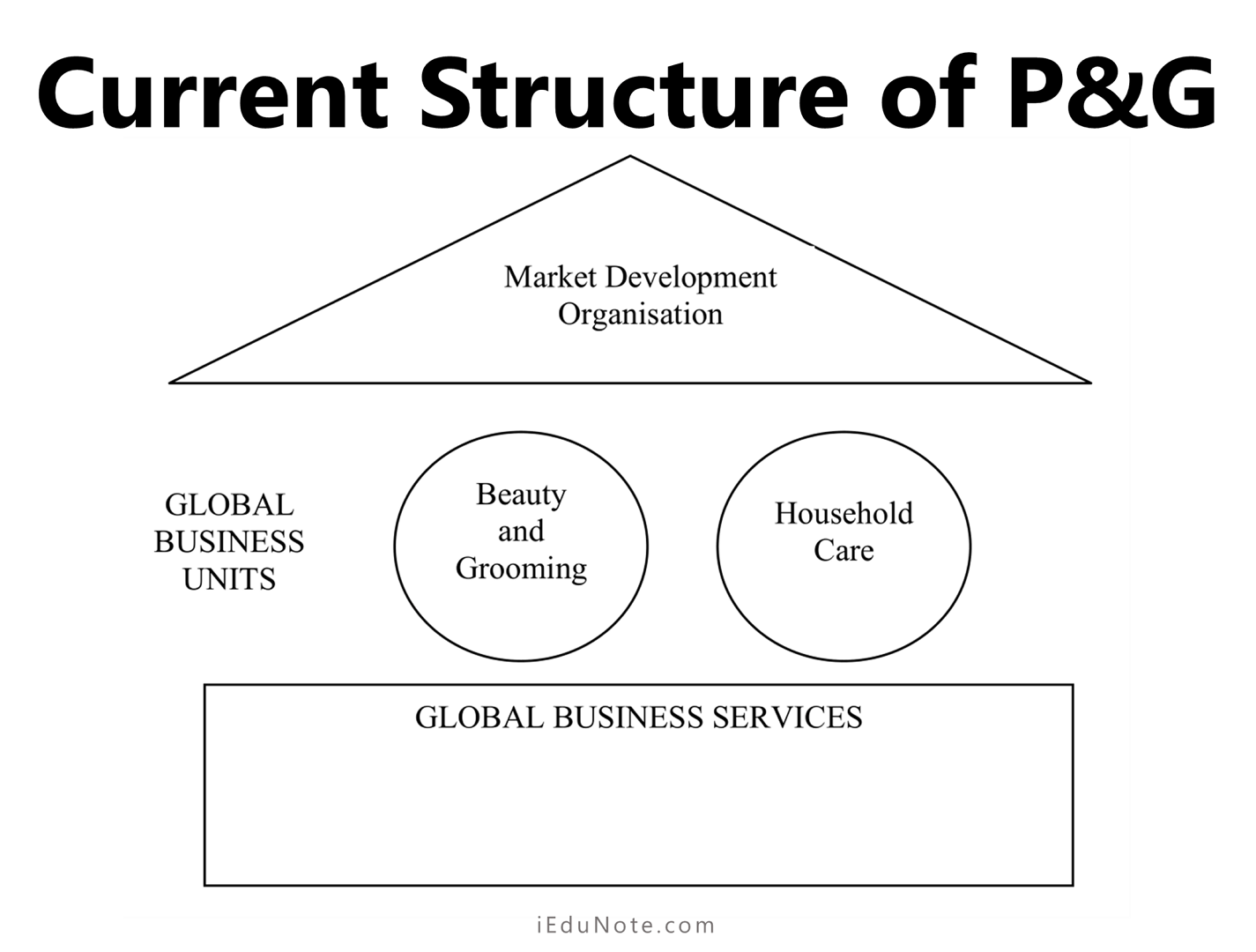
The market development unit is charged with knowing about consumers and retailers in each market and integrating the innovation from GBU into business plans.
You will notice that the building of products into two categories indicates that P&G sees marketing distribution and manufacturing-related synergy among the products (out of 300) placed with each broad unit.
Mergers, acquisitions, vertical integration, and forward integration necessitate organizational restructuring to accommodate the new tasks that have to be performed.
Structure creates the envelope within which they have been equipped with resources. A change in structure is difficult to get everybody’s acceptability the same.
A structure suited to the strategy is presumed to lead to effectiveness. In addition to the four basic structures, functional, divisional, project, and matrix organizations, the structure is also determined within the context of the country’s business practices.
Network structures are common with the Chaebols (in South Korea) or Keiretsu (in Japan.).
In network structures, groups of independent organizations have different products and markets but the same administrative and financial control. The Keiretsu are networks of related businesses, whereas the Chaebols are unrelated businesses.
The Toyota Keiretsu has a network of organizations such as Toyota Machine Works, Toyota Body Works, Aichi Steel Works, Nippondenso, and Futaba Industrial.
In contrast, the Chaebols of Samsung have networked with electronics, chemical construction, and heavy industry organizations, to name a few.
The extent of centralization versus decentralization impacts the execution of strategy. The costs associated with the structure (tall structures are expensive as they have more managerial levels as opposed to flat structures), the extent of coordination mechanism and information sharing, and the extent to which responsibility and accountability are clear.
Project Management
Objective: To transcend divisional/functional/structural boundaries.
As organizations pursue a corporate strategy, there are instances when the work they are expected to do is accomplished through a project. NASA took up the man on the moon mission.
It was impossible to devote the time and energy to all the tasks and activities for such a vision within the existing structure, budget, accountability, and skills. It was a country’s vision and a reaffirmation of humankind’s ability.
A separate project with budget, accountability, credibility, and structure was set up to accomplish that vision.
On similar lines, organizations set up projects to undertake tasks that are impossible for the organization within the confines of the present setup.
A project performs the function of freeing the organization’s resources from the current set-up to deliver more than what it is doing at the moment.
For example, an organization is pursuing growth on a very high-quality industrial product platform.
It has planned to introduce six sigma and get results for three critical divisions that will generate revenue to be plowed back into the business to retain its innovative and qualitative edge.
A project management approach to introduce six sigma would establish clear, specific, concise objectives for introducing the initiative.
To initiate six sigma initiation across three divisions, first cross-divisional teams have to be created, who will take up the assignment, and then cross-functional teams across external and internal procurement, scheduling, operations, delivery, and so on have to be taken up.
The project management team helps cut across horizontal and vertical lines in the organization for new strategy-led initiatives.
In case the strategy of an infrastructure company requires;
- erecting a new plant or developing a port,
- Then the project management approach would develop before the project (for issues such as regulatory and legal issues about land ownership, titles, environmental clearances, and fundraising),
- project in progress (design development, construction, quality assurance, resource restructuring commercial tie-ups), and
- post-project plan (marketing support, managing collaborations monitoring meeting performance targets).
For each of the three different phases, the skill pool and resources from across the organization will be identified, trained, and put on the task.
The project can be externally oriented, such as setting up a plant in Africa near raw materials and markets. The organization has no prior experience in Africa. It creates a specialist team of engineers, legal experts, designers, and liaison officers, each having a different but complementary skill set.
They help to lay the foundation of the organization’s business in an unknown land. The organization could not have done so if the people were in their incumbent positions and with the same set of rules, regulations, and accountability. The organization’s rituals of working would take too much time and may scuttle the effort.
On the other hand, the internally focussed projects are taken up to pilot quality set up ISO14000/ISO15000, six sigma employee coaching empowerment initiatives. The success of the project leads to a scale-up.
At a time, an organization may be involved with both externally oriented and internally focused projects.
Organizations may have project management skills.
However, they have difficulty initiating new change culture and learning because it means dismantling the old order.
In the absence of the project management approach, the organization faces difficulty in implementing new projects as ongoing activities take precedence, and people and other resources are not available.
The project management approach induces a sense of accountability, a sense of urgency, importance, credibility, and ownership of the task.
A project management approach puts the exercise in a time frame for accomplishment, important milestones, and control measures. The approach can help to economize time and effort.
The introduction of quality programs, environmental compliance programs, and diversity programs are facilitated sooner with the project management approach. The project enables the testing of ideas and scalability across the organization base on learning.
Programs and Plans
Objective: To establish small control units.
On the ground, it translates into delegation, empowerment, and specificity of key performance indicators.
The intent may be to offer quality service and experience. Still, if the replacement policies are opaque or require the customer to visit the store twice or thrice, or if the employees are not trained in courtesy and order processing, then the intent is not realized.
The figure below shows the interrelatedness among billing, merchandise selection, display, and policies to cater to the customer. The entire customer satisfaction objective is not fully attained if any of these are weak.
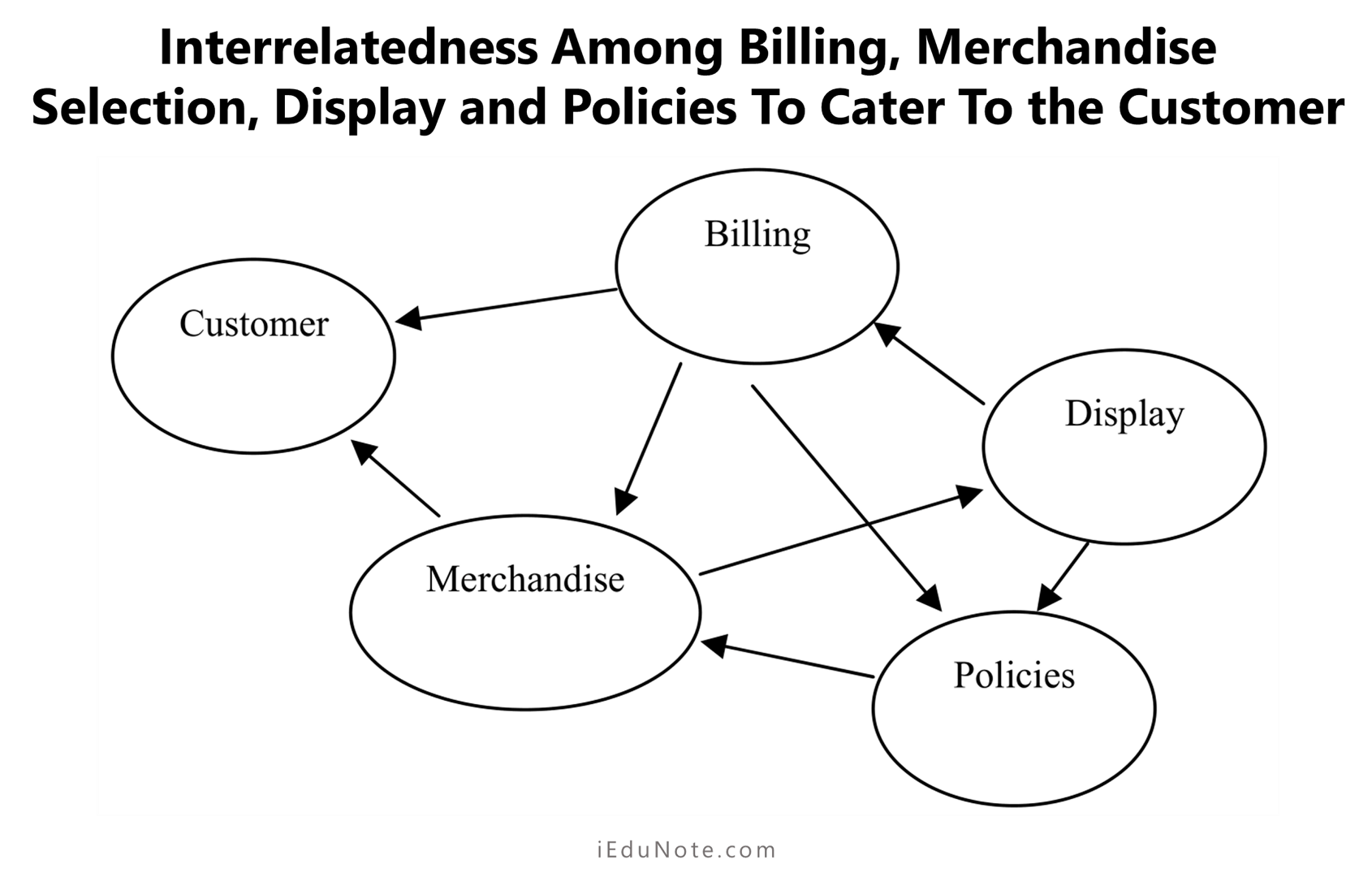
A team of cross-functional managers develops programs under the guidance/supervision of designated senior management personnel or even the CEO.
They examine the overall strategy by translating it into specific responsibilities/timelines/outcomes/resources/budgets and monitoring.
When the programs are poorly drawn up or implemented ineffectively, desired strategic outcomes are not achieved.
The programs at the lowest functional levels are drawn from the strategy-corporate, competitive, and functional hierarchy. The programs are spelled out in measures such as cash flow and so on.
Consequent to the change in the strategic stance, these measures are also redefined to lead to profitability after the changes have been made in strategy.
The figure below shows both the relationship between the programs to strategy as well as changes after the strategy shift.
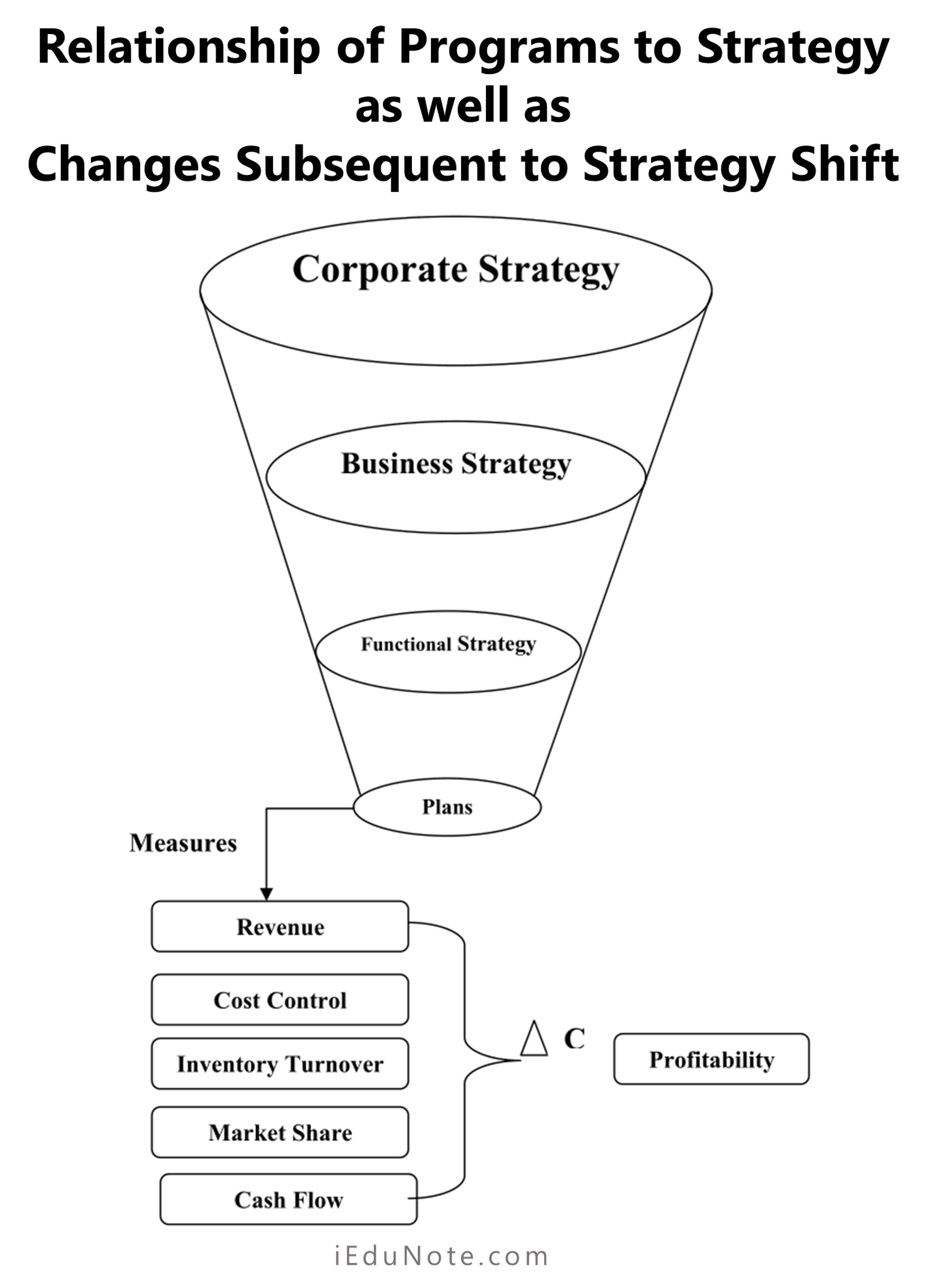
At the functional levels, much interdependence among the different activities is required. It is here that detailed specific communication about tasks, resources, outcomes, and very important links to strategy is required.
Standard operating procedures, interdependent key performance indicators, work manuals, departmental agreements, face-to-face interactions, and interdepartmental meetings are used to develop coordination.
Without such mechanisms, there is confusion and loss of coordination. Inherent contradictions among the intent, strategy, and plans may lead to avoidable strategic mistakes.
In the box below, the situation of the Indian organized retail sector is discussed. The retail sector had a favorable external environment.
The expansion of the retail sector with well-crafted strategies could have led to a different scenario for employment and growth.
However, the assumption that the customer is just waiting for organized retail to open the doors and retailers’ only worry is real estate and long-term funding led them to miss the vital aspect of customer centralism either through price or selection of merchandise.
As a result, organized retail floundered. Apart from the lack of strategic foresight, what hit it badly was the inability to develop wellthought plans.
Company policy was the mantra rather than customer policy, as shown below example.
In India, the retail sector was seen as the sunrise sector, which held the promise of growth with employment. The growth story was thwarted in part because the retail chains could not get the merchandise selection, price points, and service attributes right.
The first of the retail chains operated with the mindset of a shop owner rather than an organized retailer. This led them to be oblivious to the customer’s comfort, selection, and service needs.
Most of them compromised on quality to offer lower-priced products, assuming that customers will trade between quality and shopping convenience.
Customers wanted good quality at affordable prices, along with the shopping experience.
The unorganized sector, with its many family stores and specialized shops, was catering to the price and quality aspirations 50 percent of the time.
Organized retail had to match the quality offered by the existing stores and additionally create value on the ground that was superior to the previous experience.
The investors were upbeat about retail expansion, and PE funding was available. They expanded hastily without getting the mix of quality, experience, and price right.
The organized retail stores could not develop customer-friendly packaging (choices of smaller packaging for grocery items or policies for exchange for clothes or electronic goods, which their competitors in smaller shops could) or the right merchandise mix or customer-friendly exchange policies.
The mindset that “it won’t work here” prevented them from innovating, and organized retail could not take off as expected.
Most organized retailers fail to deliver the right mix of price, ambiance, experience, and quality to the customer. The industry experienced mergers, takeovers, sell-offs, and liquidation within a few years.
The inability to resolve the contradictions between opting for rapid growth versus getting the mix right led to many Indian retail forays closing shop. The industry could not either strategize optimally or develop good action plans for implementation.
Too many inward-looking procedures made the organizations bureaucratic rather than customercentric.
In contrast, Nordstrom empowers employees at the store level to offer exchange arrangements. The employee feels empowered, and the customer is spared the hassle of going to many people for an exchange or refund. Nordstrom’s other service standards are exacting and do not easily lead to customer disgruntlement.
Nordstrom would support its salesperson empowerment policy with requisite training about products, company credo, communication skills, and etiquette.
The training initiative has to be supported by a budget. The budget meets the training costs and, should some hiring be required, is within the budget provisions.
Consider the second example where the disconnect between the intent and the plans on the ground leads to citizens’ dissatisfaction.
In Asian countries, there is a tendency for civic organizations to build amenities without providing for their operation and management.
Later, no budget is available for repairs, replacements, or upgrades. Here it is not the lack of foresight but poor budgeting which makes the representatives unpopular with voters.
Glueck (1988) suggests five reasons why plans and programs are needed. They are developed to ensure the following:
- All the parts of an organization implement strategic decisions.
- A basis is available for controlling activities in the different functional business areas.
- The time spent by functional managers in decision-making is reduced as plans clearly show what is to be done, and policies provide the discretionary framework for decisions.
- Similar situations occurring in different functional areas are handled consistently by the functional managers.
Coordination across the different functions takes place where necessary.
Social Responsibility and Corporate Strategy
Organizations are institutions within society. They have grown to enormous proportions and consume almost all the resources that the planet has to offer
Over the last 30 years, there has been an increasing concern about the responsibility of modern commercial organizations toward society.
Why business organizations should be burdened with social responsibility is an often-asked question. The answer lies in the size, clout, and resources organizations have acquired over the last 150 years.
Undoubtedly, the main business was to earn profits; at the same time, prudence required that they act responsibly towards the society within which they function.
Social concerns have evolved over time, and organizations have responded by choosing to be more proactive rather than reactive.
Earlier, social concerns were separated from the mainstream of decision-making and were not integrated with the organization’s strategic focus.
For modern organizations, the choice is not so much about what to do or not to do but how and to what extent society’s legitimate concerns must be integrated into strategic decision-making.
Corporate social responsibility implies a commitment of the organizations to be ethically, economically, socially, and ecologically responsive voluntarily.
This extends beyond regulatory compliance, and the actions taken thus are more than the compliance requirements. The voluntary compliance of social and ecological responsibility of companies is called Corporate Social Responsibility (CSR).
Conclusion
The implementation phase actuates the formulation of the strategy. An implementation may be initiated with the formulation phase but is distinct from it. The implementation phase requires a different set of skills. It is focused on a solution.
Structure, culture, leadership, and resources plan projects are some of the things that affect implementation and are also impacted by implementation.
The plans and programs are the links between the corporate, business-level strategy, and the organization’s functional units. The plans are based on attainable targets, gradually transforming the organization towards a strategic orientation.
Information technology also plays an important role in determining the efficiency and effectiveness of the implementation.
